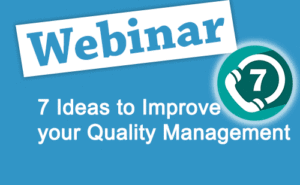Here are ten ways to improve the management of quality in the contact centre.
1. Focus on a Single Part of the Call Each Week/Month
Most contact centres do not have the time to monitor enough calls to get an entirely accurate assessment of the overall performance of its advisors.
In fact, we recently discovered that over two thirds of contact centres monitor less than seven calls per advisor, every month, as highlighted in the graphic below.
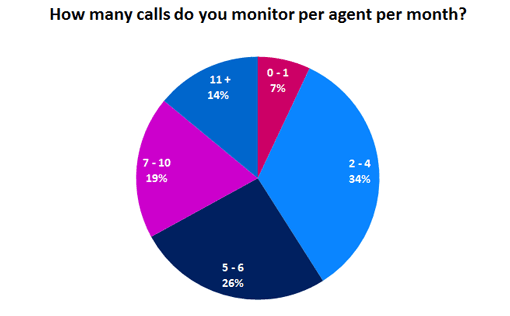
(These results were taken from the survey: Most Contact Centres Monitor Less Than Six Calls Per Agent Every Month)
So, contact centres are beginning to look for ways to evaluate more calls at a time. And one idea idea that is being trialled in reader Stephanie’s contact centre is to evaluate one part of the call at a time.
For example, how an advisor greets a caller would be taken into consideration in one month, and call analysts would simply focus on coaching advisors through that section of the call, meaning that they have more time to listen to more calls.
The quality team at Stephanie’s contact centre would then: “categorise the action/improvement areas, rank advisors on the type of actions and rank them on if they’ve achieved their action or not.”
While focusing on one specific call segment “frees up” more time to assess a greater number of calls, the contact centre could also focus on a different call type each month. So, instead of monitoring six calls per advisor, every month, the contact centre could examine a random 400 calls of a specific all type each month.
This, according to Sarah Kennedy, a contact centre specialist, would allow the contact centre to give “greater focus on call types that always get a failing customer grade”, while freeing quality management “from the tyranny of performance metrics.”
For more on this topic, read our article: Does our Approach to Contact Centre Quality Need to Change
2. Hold Quality Calibration Sessions
A key part of monitoring quality in the contact centre is to recognise whether advisors are demonstrating soft skills, such as empathy, over the phone.
However, different analysts may have different ideas of what constitutes empathy, meaning that different definitions will spread through the contact centre floor. This does not equate to consistent customer service and causes confusion.
So, Fran Corke, Senior Service Quality and Engagement Manager at OVO Energy, suggests conducting calibration sessions, which promote “healthy discussion about what ‘good’ and ‘bad’ looks like, as well as encouraging healthy debate.
“We find feedback can be more powerful from a peer and the sharing of top tips is great.”
As well as encouraging consistency across the business, calibration sessions will help make the quality process fairer and more transparent for advisors. The quality process becomes standardised, so that conversations like: “well, Jon didn’t get marked down for that,” become a thing of the past.
Find out how to run such sessions in our article: How to Calibrate Quality Scores
3. Create a Scorecard Based on Driving Positive Behaviours
Some contact centres are moving away from scorecard-based quality, instead focusing on more general coaching. This eliminates the “did the advisor say the customer’s name three times” type of criteria.
However, these scorecards are helpful in creating quality scores that can be used as a metric to track advisor performance. So the contact centre could instead modify their scorecard to drive behaviours, as opposed to focusing on specific outcomes.
Paul, one of our readers, recommends this, stating that behaviour-based scorecards should look at “how effective was the information provided and what was the strength of the conversation.
“We all know what a poor conversation looks like, unhelpful, lack of ownership, poor product knowledge, incorrect information… and be very transparent with the advisor about what behaviours the business is looking for OR what does good look like – how do we make it great?!”
Follow the link for an expert opinion on: The Best Way to Measure Call Centre Quality
4. Spread the “i-Quality” Message
In reader Coleen’s contact centre the quality initiative is otherwise known as “i-Quality”.
Why? Because their contact centre team like to point “to the fact that it’s ‘my’ responsibility, ‘I’ am in control and drive the outcome and the overall outcome is based on how ‘I’ perform.”
“It’s all about realising that my efforts and performance make a difference to the performance of the team as a whole. It gives the idea that everyone gets involved in the success of the organisation.”
Creating niche sayings and mottoes, like the one above, can also be used to boost a proactive contact centre culture.
For example, when we visited AO’s contact centre, we discovered that they spread phrases such as: “treat the customer like your Gran” and “what would Ann Robinson say?” to spread a message of both fun and customer care.
So, perhaps a name like “i-quality” could help boost enthusiasm and attitudes towards quality.
5. Encourage Self-Assessment and Ensure Advisors Know How They Can Develop
According to Tom, another of our readers, “it’s incredibly important to encourage self-assessment. It’s easy to tell people what they’re doing wrong, but most likely they are not going to improve.
“Give your advisors the chance to evaluate their calls/live chats and they will be able to find their flaws and will more likely try to rectify them in the future. They will be more aware of how to improve if they evaluate themselves.
“That’s the way to make advisors focus and experience the customer service they provide from the outside point of view.”
While this is good advice, regular and constructive feedback sessions are key as well. Advisors must know what they are doing wrong and understand why and how to develop and change.
Tom agrees, concluding by saying that if advisors “see that you’re passionate about the customer service and their personal improvement, they are more likely to take to heart everything you’ve said. It’s simple, but unfortunately a lot of people forget about it.”
6. Ask Advisors if They Have any Particular Calls That They Would Like to Review
Many contact centres invest in technology to highlight the calls that are potentially of most value in terms of helping analysts to coach advisors. But this can be done by simply asking advisors to highlight a few calls to be submitted for review, if advisors do not shy away from revealing their lower-quality calls.
In Paul’s contact centre, he encourages advisors to submit calls “both in terms of aspects within the call they felt went well, along with areas of the call they felt that could improve.”
But, Paul stresses that “the key point being moving away from a potential outcome of call monitoring being performance management/disciplinary to an opportunity for constant improvement.”
7. Teach Advisors About Cognitive Biases
Understanding how people make choices and how this can be influenced can certainly boost a contact centre interested in improving conversion rates and can also be useful for customer service entities.
So, learning how to present offers to customers that appeal to their cognitive biases can be a good tactic to employ when refining quality of performance.

Duncan White
As Duncan White, the Managing Director of horizon2, says: “Many decisions that we think are unbiased and rational are in fact based on automatic and sometimes unconscious reactions, driven by the situation and the context.
“How you present a choice changes the way that people behave. This is a comparison bias as people like to contrast and compare.”
To highlight this principle, The Economist offered its customers two choices: a web subscription and a print plus web option. Most people chose the web subscription alone.
However, when a third option was introduced; print only, for the same price as the print plus web offer, the preferences swung the other way, as highlighted below.
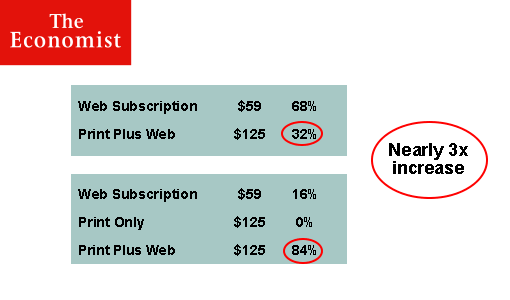
So, perhaps the contact centre should reconsider how offers are put to customers in quality sessions.
Duncan White did so at a debt-collection contact centre by changing how options were presented to people in terms of how they could pay back their debt.
In fact, Duncan White says that “changing the way advisors structure the conversation took their collection rate from 70% to 90%.”
8. Compare and Contrast Quality Across Different Channels
Typically, synchronous conversations are where the conversation is going both ways at all times and there are different expectations around synchronous channels than there are around asynchronous channels.
| Synchronous | Asynchronous |
|---|---|
| Telephone | SMS |
| Webchat | Instant Messaging |
| Face to Face |
The contact centre needs to understand what those expectations are and structure conversations to meet them.
This, according to Duncan White, is because “a typical customer journey will now embrace more than one channel, so if quality monitoring can be built around journey analytics rather than contact analytics, then you are measuring the end-to-end journey of your customer, as opposed to looking outside-in.
“For this reason, it is important to monitor consistently across all channels. Finding out what the source of the contact actually was, and solving that, will help to improve quality in the long run.”
9. Don’t Only Monitor What You Can – Make Sure Focus Is Aligned With Targets
Peter Drucker – the famous management consultant, educator, and author – once gave the following quote:
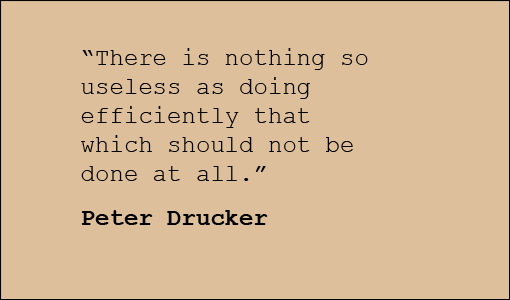
This comment has great relevance when it comes to contact centre metrics, as it is important to avoid monitoring something just because you can. All contact centres need to ensure that metrics are aligned with targets.
Duncan White makes this point when referencing contact centres that base quality of certain metric scores, stating that “there’s no point doing something well if it has no impact on what you are actually doing.”
For example, just because the contact centre has the capability to measure Average Handling Time (AHT), this does not make it a satisfactory indicator of advisor performance. This is because advisors who take longer on the phone may be those who are going the extra mile for the customer. It does not necessarily indicate that some advisors are handling calls less efficiently than others.
For more on this topic, read the article: Is Reducing Average Handling Time a Good Idea?
10. Balance Regulatory Need and Business Effectiveness
Quality needs to focus on other outcomes rather than compliance only. A good conversation has a number of different outcomes.
However, the number of different outcomes that contact centres consider has grown over the past few years, as Duncan White says that: “20 years ago, quality mainly focused on what the experience was like for the customer, but now contact centres realise that there a number of different outcomes. The big three are the customer, business and efficiency outcomes.”
However, Duncan White now says that he believes that the big three should be expanded to a big six, with employee, insight and regulatory aspects being included also.
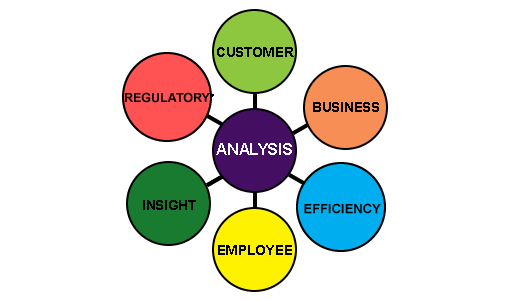
So, when developing a scorecard, or just when giving general guidelines, quality analysts should keep all six elements in mind, to provide consistent service that works for every contact centre department.
Do you have any ideas for improving contact centre quality?
If so, please share them in an email to Call Centre Helper.
For more tips on quality-based processes in the contact centre, read the following articles:
Author: Robyn Coppell
Published On: 30th Oct 2017 - Last modified: 8th Sep 2025
Read more about - Hints and Tips, Duncan White, Quality








